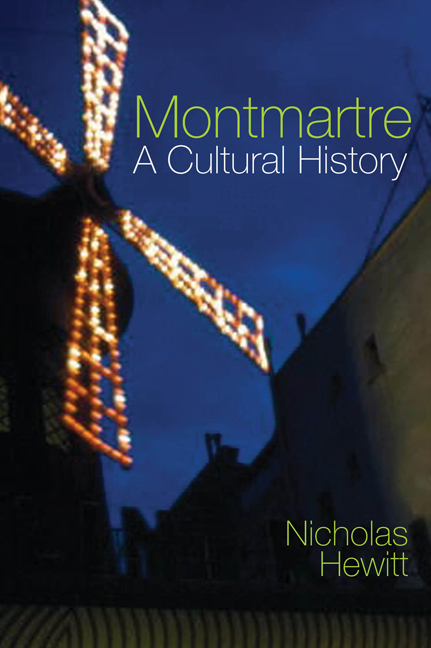Book contents
- Frontmatter
- Dedication
- Contents
- List of Illustrations
- Acknowledgements
- Map
- Introduction
- 1 ‘Montons à la Barrière’
- 2 The Artistic Cabarets
- 3 Music Halls and Mass Culture
- 4 Theatre and the Avant-Garde
- 5 The Bateau-Lavoir and the Lapin Agile
- 6 Wartime and the Années Folles
- 7 The Place of Memory
- 8 The Ecole de Montmartre
- 9 The Occupation: Céline and Aymé
- Epilogue: Montmartre on Film
- Bibliography
- Index
- Plate section
8 - The Ecole de Montmartre
- Frontmatter
- Dedication
- Contents
- List of Illustrations
- Acknowledgements
- Map
- Introduction
- 1 ‘Montons à la Barrière’
- 2 The Artistic Cabarets
- 3 Music Halls and Mass Culture
- 4 Theatre and the Avant-Garde
- 5 The Bateau-Lavoir and the Lapin Agile
- 6 Wartime and the Années Folles
- 7 The Place of Memory
- 8 The Ecole de Montmartre
- 9 The Occupation: Céline and Aymé
- Epilogue: Montmartre on Film
- Bibliography
- Index
- Plate section
Summary
In his preface to Les Veillées du Lapin Agile (1919), Francis Carco refers to ‘une génération qui, après celle du Chat Noir, a contribué pour beaucoup à donner à la jeune littérature actuelle un caractère original’ (‘a generation, which, after that of the Chat Noir, has greatly helped to give to contemporary young literature an original character’): the writers of what Armand Lanoux called the ‘Ecole de Montmartre’. The three main figures were the novelists Roland Dorgelès, Carco himself and Pierre Mac Orlan, followed, as we shall see in Chapter Nine, by Marcel Aymé and Louis-Ferdinand Céline. These three writers produced a body of fiction, essentially in the realist tradition, which adds to our knowledge of the literary history of the interwar years, and wielded considerable influence on the literary establishment, especially through their membership of the Académie Goncourt. It is interesting, however, that while they are prolific, even obsessive, memorialists of pre-war bohemia, their fictional accounts of Montmartre are remarkably few in number, as if the subject matter of the memoirs does not present the same possibilities for fictional transposition. Nevertheless, their major novels on Montmartre – Carco's Jésus-la-Caille (1914), Mac Orlan's Le Quai des brumes (1927) and Dorgelès's Le Château des Brouillards (1932) – provide important contrasting images of the Belle Epoque which resonated in different ways in the interwar years and complement the work of the non-fictional memorialists and the caricaturists of the Restaurant Manière. All three came to the Butte at the height of its fame as a centre of Parisian bohemia – Mac Orlan in 1899, Dorgelès in 1906 and Carco in 1910 – and their fictional treatment of Montmartre before the First World War constitutes an important element in the literary history of the interwar years.
Technically, unlike the avant-garde, and younger writers like Céline and Aymé, these writers are not primarily innovators, rejecting self-consciousness and operating largely within a recognisable realist tradition. Although Mac Orlan is by far the most conscious of his literary context and has the greatest intellectual scope, his novels nevertheless follow well-established narrative patterns like the folk tale or the pirate story.
- Type
- Chapter
- Information
- MontmartreA Cultural History, pp. 203 - 238Publisher: Liverpool University PressPrint publication year: 2017



